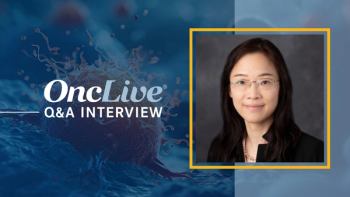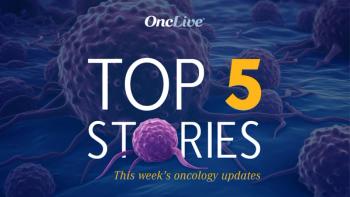
Molecular Testing for NSCLC in 2019
Transcript:
Benjamin Levy, MD: Thank you for joining us for an OncLive Peer Exchange® panel discussion on precision medicine in non—small cell lung cancer.
Results of recent clinical trials in lung cancer have led to a transformation in thoracic oncology, as we persist in exploring new therapeutic targets.
In this OncLive Peer Exchange® discussion, “Precision Medicine in Non-Small Cell Lung Cancer: Ramifications of Recent Data,” I am joined by a panel of experts in lung cancer clinical research. Today we will discuss key data that impact the way you treat your patients, including updates from the 2019 ASCO [American Society of Clinical Oncology] annual meeting.
I am Dr Benjamin Levy, associate professor of oncology and clinical director of medical oncology at the Johns Hopkins Sidney Kimmel Cancer Center at Sibley Memorial Hospital in Washington, DC.
Participating today on our panel are:
Dr Joshua Bauml, assistant professor of medicine at the Perelman School of Medicine at the University of Pennsylvania, Philadelphia, Pennsylvania.
Dr Ross Camidge, Joyce Zeff chair in lung cancer research at the University of Colorado School of Medicine in Aurora, Colorado.
Dr Bob Doebele, an associate professor in medicine at the University of Colorado School of Medicine in Aurora, Colorado.
And Dr Zofia Piotrowska, a medical oncologist at Massachusetts General Hospital and instructor at Harvard Medical School, Boston, Massachusetts.
Thank you for joining us. Let’s begin. I think we’ve come a long way in the past 5 years with the identification of actionable mutations and the delivery of targeted therapies. Lung cancer truly has been, I believe, I think we all believe, a poster child for precision medicine. The story obviously begins with EGFR and ALK. But we’ve made some headway in other mutations that may be relevant and need to be tested. Zofia, I’ll ask you first. What are the recommendations currently for molecular testing for advanced stage adenocarcinoma of the lung?
Zofia Piotrowska, MD: I think testing is incredibly important, and not just testing but also, importantly, waiting for the results of the testing to be sure you have all of the information when making a treatment decision. According to the NCCN [National Comprehensive Cancer Network] guidelines, all patients with stage IV nonsquamous lung cancers should be tested, and those with squamous cell cancers should be strongly considered. I think it’s important not just to look for the common targets with approved therapies like EGFR, ALK, and ROS1, but we are seeing more rare novel targets that are becoming actionable, that have great therapies for them. In my practice, doing a broad panel up front, doing next-generation sequencing [NGS]-based testing right at the beginning, so that you know all of the information about the patient’s cancer and can select the appropriate first-line therapy for that patient. I think that’s critical and certainly is something that I do routinely for my stage IV patients.
Benjamin Levy, MD: So how does this go down in your institution? You do comprehensive genomic profiling, in addition do PD-L1 [programmed cell death protein 1]? How do you integrate PD-L1 into this process?
Zofia Piotrowska, MD: We do both. The PD-L1 does get reflexively done by our pathologists on any pathology that comes back of non—small cell lung cancer. We get that back. Usually, we get that back quicker than molecular testing, which is an important point because often there’s an impetus to treat based on PD-L1, but in fact it’s important to wait for the molecular to come back. We have an in-house NGS panel that usually takes about 1 to 2 weeks to come back, as well as an RNA-based fusion panel that picks up some of the....
Benjamin Levy, MD: Two different sequencing panels you’re using.
Zofia Piotrowska, MD: Yes, exactly, to cover all of the common and less common targets.
Benjamin Levy, MD: OK, so you get all, one-stop shopping.
Zofia Piotrowska, MD: Yes.
Benjamin Levy, MD: It all comes back. What’s the turnaround time for the NGS at your institution?
Zofia Piotrowska, MD: I think realistically we can say 2 weeks. Sometimes we get lucky, it’s a little bit shorter, but I think on average about 2 weeks from the time of the biopsy.
Benjamin Levy, MD: Within that comprehensive testing, you’re getting EGFR, you’re getting ALK, ROS, and BRAF, the approved agents, but you’re also getting these rare genetic alterations that are potentially actionable—MET, RET, HER2.
Zofia Piotrowska, MD: Yes, I think one of the nice things has been that the panel has been expanded each year as new targets are found, for example, NTRK and others. The panel has been adapted to include anything that’s potentially actionable.
Benjamin Levy, MD: Josh, talk a little bit about in-house panels and the value of bringing NGS. You’re at Penn and you’re doing an in-house assay there. What’s the value of having an in-house assay versus farming it out to a company like Foundation Medicine? How do you have to coordinate with everyone else who’s a part of the tissue procurement and processing to get things done within the institutional walls?
Joshua Bauml, MD: I think that there are a lot of advantages to doing it in-house because the pathologists get the tissue and then they can immediately get it started to going toward the pathway as opposed to if you have to send it out, it’s a whole separate process. I will say that whatever testing is done, one of the important things is knowing what your testing is, and knowing what the limitations of that test are, and what it’s looking for, what it’s not.
One of the major barriers that I’ve seen from colleagues in the community is they do a test, they say, “This tumor was tested.” And I say, “Well, what test happened?” They say, “Well, it was tested.” And it’s important to know more than that, unfortunately, because if you do a DNA-based NGS assay, it may not be able to detect fusions. When you go through the list of things, it might say we’re looking at NTRK, but that’s only looking at NTRK mutations, which are not clinically actionable. It’s very important that you know not only that the tumor is tested but how it’s tested. I think that having it as an in-house assay, which we have—and we have a similar process to what you were describing, Zofia, where we have a DNA-based assay and an RNA-based fusion assay—allows us to get this moving as fast as possible, so we can get the results and act on them.
Zofia Piotrowska, MD: I would add too, I think that’s a good point. Sometimes you see patients where testing has been performed, but sometimes the testing was done a year or two prior. It’s not just important to see what test was done, but what genes it covered.
Joshua Bauml, MD: Absolutely.
Zofia Piotrowska, MD: Because, you know, there are some cases where it may not actually have been tested for MET and now it’s important to go back and retest.
Joshua Bauml, MD: One other factor that is important is what piece of tumor was being tested. I think that often I’ve seen patients have bone biopsies undergo testing, and the decalcification process degrades the DNA. If I have a patient who comes in and they had a bone biopsy and that’s what their NGS is based off of, I will often repeat the test with a new biopsy because I just don’t think we can rely on those results.
Transcript Edited for Clarity

























































































